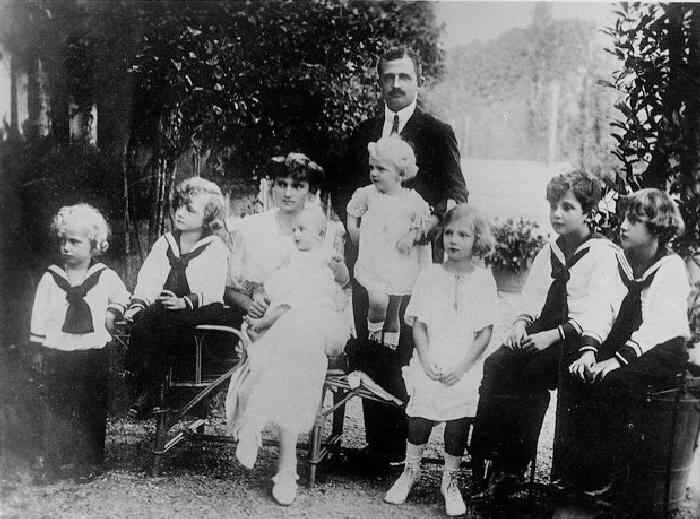
Austrian Royalty: Emperesor Karl and Emperess Zita's Children--Clothing Styles

Figure 1.--Here we see the royal family in 1921, just before Karl launched the aborted effort to seize the Hungarian crown. A new baby daughtr has arrived, but the fa,ily is not yet complete. The boys are now wearing long pants sailor suits. Notice that Otto's long hair has been cut, but not long.
|
|
Emperess Zita liked to dress the children in coordinated or identical outfit. As babies the children wore white dressess. There seem to have been starndard outfits for the boys and standard outfits for the girls. Zita seems to have based the standard boy's oiutfit on the clothes worn by the oldest boy--Otto. When he had his hair cut and began wearing sailor suits, so did the younger boys. We see Otto, the oldest child wearing a broad-brimmed hat with down turnd brim with a tunic jacket and straight-leg shorts. As best we can tell he wears short pants and not knee pants. We also see him wearing a regular broad-brimmed hat. A few years later all the boys are wearing frilly white blouses and short pants. We also see them wearing what look like t-shirts and white short pants Later when the boys are a little older they wear sailor suits with long pants. The children commonly wore strap shoes, both dark and white as well as high-toped shoes.
Royal Era (1912-18)
Empress Zita as might be expected for the empress of Austria was a very stylish induvidual. Young Prince Otto appears to have been one of the most stylishly dressed boys in Europe. Prince Otto wore frilly white dresses and long hair. Even after breeching he wore frilly short pants outfits and is long flowing locks were not cut. Even after the fall of the monarcy the children were dressed very stylishly. None of the other boys, however, were dressed in the extremely fancy outfits that Otto wore as a young boy before the royal family was forced to abdicate. She appears to have liked dressing the children in similar outfits, with Otto in short pants and his sister wearing a skirt. Otto and Adelheid appear in a 1919-20 photograph dressed in blue sailor suits (figure 6). Otto still has his long curls. A photograph taken in Switzerland shows the children fishing with their father in Switzerland during 1920.
They wear similar casual outfits.
Early Exile (1918-20)
Even after the fall of the monarcy the children were dressed very stylishly. None of the other boys, however, were dressed in the extremely fancy outfits that Otto wore as a young boy before the royal family was forced to abdicate. She appears to have liked dressing the children in similar outfits, with Otto in short pants and his sister wearing a skirt. Otto and Adelheid appear in a 1919-20 photograph dressed in blue sailor suits (figure 6). Otto still has his long curls. A photograph taken in Switzerland shows the children fishing with their father in Switzerland during 1920.
They wear similar casual outfits. Adelherd wears a white skirt and the boys white short pants. All three children wear strap shoes and white ankel socks. Otto still has his long hair. The available photogrphs that Otto even at 8 years old in 1920 was wearing his hair quite long. In fact Otto appears to be wearing is hair longer than his younger brother and even his sister. I'm not sure just whose idea this was. It seems unlikely that his mother would insist that her older son wear his hair longer than is younge brother and sister, but this aooears to have been the case. Otto seems to have been quite special to his mother. One contributor tells me that Otto wore his hair long until he was about 12 years old.
Exile (1920-30s)
The children's father Emperor Karl attempted to revive the monarchy in Hungary. He failed and was arrested. Thus a Napoleon-like solution to the “Habsburg problem” was decided upon by the ambassadors. He was exiled to Madeira and the British Royal Navy deposited him there (November 19, 1921). He was destitute. A local banker provided him a home up in the mountains. Maderira is a rainy island and the climate was not good for Karl's already weak health. The children joined them there. Karl caught a cold which developed into pneumonia (March 1922). Zita was again pregnant when Karl died. It has been aledged that Maderia was specifically selected because Karl had weak lungs and the wet climate was not healthful climate for him This left Zita alone with the children. Gradually in the 1920s the Austrian princes began to wear less fancy clothes anf shorter hair. In part is a reflection of how significantly boys clothing changed after World War I (1914-18). A photograph taken in 1927, for example, shows the boys dressing as in wealthy European family might dress. Prince Otto who would have been about 15 years old wears a mature-looking knicker suit.
HBRC

Navigate the Boys' Historical Clothing Web Site royal pages:
[Return to the Main Emperor Karl page]
[Return to the Main Emperess Zita page]
[Austria ]
[Belgium]
[France]
[Germany]
[German states]
[Italy]
[Monaco]
[Netherlands]
[Norway]
[Romania]
[Russia]
[Spain]
[United Kingdom]
Created: 2:35 AM 2/22/2006
Last updated: 11:39 PM 5/31/2009



